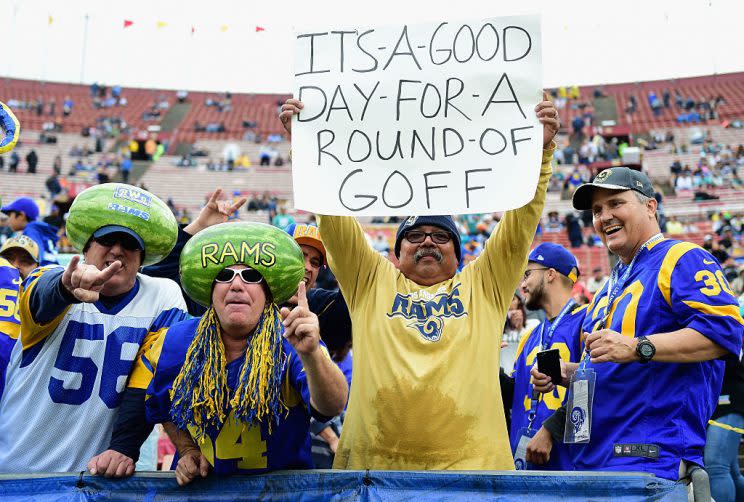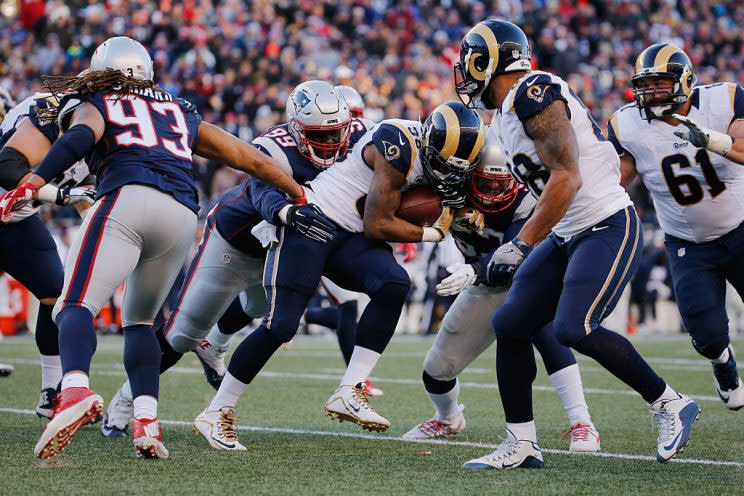Juggernaut Index, No. 29: Draft Rams at your own risk

This season, I’m unveiling a new team-building strategy for fantasy managers, applicable in leagues of any size. I’ve run thousands of simulations, so I’m feeling pretty good about it. With my cutting-edge ZeroRams™ system, you will enter the draft room several steps ahead of the competition. The underlying math is very complicated, but the basic guiding principle is this: Rams are bad and you don’t want them.
[Fantasy Football is open! Sign up now]
OK, perhaps that approach is too simple. But in standard redraft leagues, if you avoid this team on draft day, you will not be filled with regret at the end of the year. Just quickly scroll down to the bottom of the post and check this team’s 2016 rankings in terms of yardage and scoring. Not good.
This year’s offense should be more inventive and far less predictable under new head coach Sean McVay and coordinator Matt LaFleuer, but the Rams have a long road ahead to reach mediocrity. Over the past three seasons, McVay served as the OC in Washington, working with Kirk Cousins; LaFleur spent the past two years as Matt Ryan’s position coach in Atlanta. Both coaches have excellent histories, clearly, and both are under 40. If you’re a Rams fan, I’m sure you’re happy to simply move beyond the Jeff Fisher theater of pain.
The critical short-term challenge facing McVay and LaFleur is to transform last year’s No. 1 overall pick into something that resembles a franchise QB.
When Jared Goff is slinging the ball…
…avert your eyes.
Last season, it wasn’t exactly a quarterbacking clinic in L.A. There’s no shame in struggling as a first-year NFL passer, but Goff’s numbers were dreadful over his seven starts: 155.6 Y/G, 5.31 Y/A, 54.6 completion percentage, 5 TDs, 7 INTs, 5 fumbles, 26 sacks.
Here’s the full list of rookie quarterbacks over the past 25 years who attempted 200 passes and averaged less than 5.4 Y/A:
Blaine Gabbert, 2011 – 5.36
Joey Harrington, 2002 – 5.35
Jared Goff, 2016 – 5.31
Ryan Leaf, 1998 – 5.26
Jimmy Clausen, 2010 – 5.21
Kyle Orton, 2005 – 5.08
Bruce Gradkowski, 2006 – 5.06
Donovan McNabb, 1999 – 4.39
McNabb aside, that is not great company. For comparison’s sake, Marcus Mariota, Jameis Winston and Dak Prescott averaged better than 7.5 Y/A as rookies.
Goff worked behind a miserable O-line last season, of course, and he was throwing to a thoroughly unimpressive group of receivers. It’s not as if he was set up for immediate success. But he was also responsible for plenty of misfires and misreads — regrettable throws like this thing right here. It should go without saying that Goff is not ownable in standard fantasy leagues; one of your primary goals in a two-QB format should be to avoid him.
Kenny Britt led the Rams in every meaningful receiving category last year, but he left for Cleveland via free agency. Tavon Austin remains, but he’s coming off a season in which he averaged only 8.8 yards per catch. He had surgery on his left wrist during the offseason, but should be good to go when camp opens. Austin’s single-season high in receiving yardage is just 509, and he hasn’t averaged more than 10 yards per reception since his rookie season. He has only one career 100-yard receiving effort. No need to draft him, except in the largest leagues.
The Rams won the Robert Woods sweepstakes in the offseason, so, um … woo. Woods seems miscast as a No. 1 receiver, but he’ll presumably fill that role in L.A. He’s a reliable enough route-runner who can take a hit, but he doesn’t have exceptional size, speed or athleticism by NFL standards. He’s fine — not a special talent, but fine. He’s likely to see 100-plus poor-quality targets in 2017; Britt was targeted 111 times last year.
Second-year receiver Mike Thomas showed us very little as a rookie, unless you count this…
Mike Thomas is WIDE OPEN for the #LARams. And he drops it. #LAvsSEA pic.twitter.com/2wT0CNl2r9
— Chat Sports (@ChatSports) December 16, 2016
…and Pharoh Cooper did next to nothin’ (14-106-0). L.A. drafted a pair of receivers this year, Cooper Kupp and Josh Reynolds, who could have been interesting fantasy sleepers had they landed elsewhere. Kupp was a dominant four-year player at Eastern Washington, establishing career FCS records for receptions (428), receiving yards (6464) and touchdowns (73). Before you write him off as a small school wonder, note that he consistently did his best work against Pac-12 opponents. He should have the slot role immediately for L.A. Reynolds is an intriguing prospect with good size (6-foot-3), deep speed and leaping ability, but he’s more of a developmental project than Kupp.
We’re likely to see plenty of two-tight end looks from the Rams, and the team just used a second-round pick on South Alabama’s Gerald Everett, a prospect of interest. Everett has the hoops-to-gridiron backstory that fantasy owners like to see, but he’s strictly for the dynasty crowd. It’s difficult to imagine L.A.’s receiving corps supporting even one consistent fantasy option, and that lone receiver certainly won’t be a rookie tight end. Let’s move on.

What the heck happened to Todd Gurley? He used to be good, no?
This, of course, is the big question surrounding this team for fantasy purposes in 2017. Gurley’s second-year collapse was truly remarkable. He was an occasionally thrilling and always competent runner in 2015, rushing for 10 TDs and 1106 yards at 4.8 YPC. Gurley delivered quality games in the most difficult division matchups. He was everything we expected to see from a first-round running back.
Last year, however, Gurley hardly generated a highlight. He gained just 3.2 YPC and rushed for 55.3 yards per game. Only two of his 278 carries went for 20-plus yards. The season before, he had five carries of 40 or more yards. His reception total jumped from 21 to 43, which helped in a small way in PPR formats, but he found the end-zone just six times on 321 touches. It was ugly. Wretched line play was a factor, as was Gurley’s own impatience. And we can’t ignore the fact that opposing defenses essentially begged the Rams to throw the ball.
This year, L.A.’s offensive line should improve following the additions of veteran LT Andrew Whitworth and center John Sullivan. The coaching and play-calling upgrades should pay dividends as well. These things can only help Gurly. Still, this team has so many young players digesting playbooks, and the overall talent level of the offense remains relatively low. If Gurley can simply split the difference between his stellar 2015 performance and last year’s debacle, fantasy owners should be satisfied. His current draft price is a bit too rich for me (ADP 21.4, RB10). Lance Dunbar was added to the backfield mix, and he’s an obvious threat to Gurley’s third-down touches.
When the Rams are defending…
This unit was not the problem last season. L.A.’s defense ranked top-10 in terms of total yards allowed (337.0 YPG), yards per pass attempt (6.7) and yards per carry (3.9). Linebackers Alec Ogletree and Mark Barron are excellent IDP options, and two-time All-Pro DT Aaron Donald is a terror, a dominant disruptive force. Blitz-happy Wade Phillips is now the DC, which doesn’t hurt this D’s fantasy outlook.
So the Rams should be tolerable in at least one phase. Here’s hoping the offense can take a step or two forward under new coaching.
2016 Offensive Stats & Ranks
Points per game – 14.0 (32)
Pass YPG – 184.4 (31)
Rush YPG – 78.3 (31)
Yards per play – 4.4 (32)
Plays per game – 60.0 (31)
—
Previous Juggernaut Index entries: 32) NY Jets, 31) San Francisco, 30) Cleveland, 29) LA Rams



